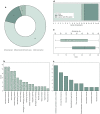Development of a digital intervention for psychedelic preparation (DIPP)
- PMID: 38374177
- PMCID: PMC10876638
- DOI: 10.1038/s41598-024-54642-4
Development of a digital intervention for psychedelic preparation (DIPP)
Abstract
Psychedelic substances induce profound alterations in consciousness. Careful preparation is therefore essential to limit adverse reactions, enhance therapeutic benefits, and maintain user safety. This paper describes the development of a self-directed, digital intervention for psychedelic preparation. Drawing on elements from the UK Medical Research Council (MRC) framework for developing complex interventions, the design was informed by a four-factor model of psychedelic preparedness, using a person-centred approach. Our mixed-methods investigation consisted of two studies. The first involved interviews with 19 participants who had previously attended a 'high-dose' psilocybin retreat, systematically exploring their preparation behaviours and perspectives on the proposed intervention. The second study engaged 28 attendees of an ongoing psilocybin retreat in co-design workshops, refining the intervention protocol using insights from the initial interviews. The outcome is a co-produced 21-day digital course (Digital Intervention for Psychedelic Preparation (DIPP)), that is organised into four modules: Knowledge-Expectation, Psychophysical-Readiness, Safety-Planning, and Intention-Preparation. Fundamental components of the course include daily meditation practice, supplementary exercises tied to the weekly modules, and mood tracking. DIPP provides a comprehensive and scalable solution to enhance psychedelic preparedness, aligning with the broader shift towards digital mental health interventions.
Keywords: Co-design; Digital intervention; Meditation; Person-centred; Psilocybin; Psychedelic preparedness; Psychedelic therapy; Psychedelics; Qualitative.
© 2024. The Author(s).
Conflict of interest statement
The authors declare no competing interests.
Figures





References
MeSH terms
Substances
Grants and funding
LinkOut - more resources
Full Text Sources

